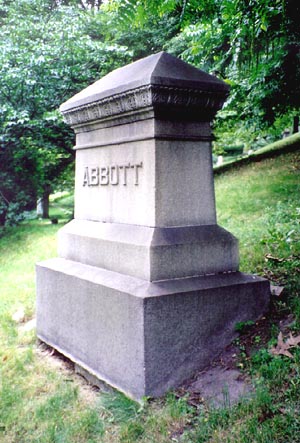Anderson Ruffin Abbott was born in Toronto, Canada, the son of Wilson Ruffin Abbott and and Ellen (Toyer) Abbott. The Abbotts were a prominent black family in Toronto who, as free people of color, had left Alabama after their store had been ransacked. After living a short time in New York, the family relocated to Canada in 1835 or 1836. Wilson Abbott began to purchase real estate in and around Toronto; he owned 48 properties by 1871 and also became active in politics.
 |
| Wilson Ruffin Abbott |
The family's prosperity allowed Anderson to receive an excellent education. He attended both private and public schools. He was an honor student at the Toronto Academy, and later attended Oberlin College in Ohio.
He graduated from the Toronto School of Medicine 1857. He then studied for four years under Alexander Thomas Augusta, a fellow black physician.
He was 24 years old when the Civil War began.
Abbott received a licence to practice medicine from the Medical Board of Upper Canada in 1861, becoming the first Canadian-born black doctor.
Abbott applied for a commission as an assistant surgeon in the Union Army in February 1863 but his offer was evidently not accepted. That April, he applied to be a “medical cadet” in the United States Colored Troops. He was eventually accepted as a civilian surgeon under contract.
In 1866, Abbott resigned from service to the Union Army and returned to Canada. He established a medical practice and was admitted to the College of Physicians and Surgeons of Ontario in 1871.
Like his father, Abbott became an important member of the black community in Toronto. From 1873 to 1880, he fought against racially segregated schools. He was appointed coroner for Kent County, Ontario in 1874, the first Black man to hold that office.
In 1894, Abbott was appointed surgeon-in-chief at Provident Hospital in Chicago, the first training hospital for black nurses in the United States. He became the hospital's medical superintendent In 1896 but resigned the following year.
At the age of 76, Abbott died on December 29, 1913, at the Toronto home of his son-in-law Frederick Langdon Hubbard, son of his long-time friend William Peyton Hubbard.
 |
| Alexander Thomas Augusta |
He was 24 years old when the Civil War began.
 |
| Washington, D.C. during the Civil War |
He served in Washington, D.C. from June 1863 to August 1865, first at the Contraband Hospital, which became Freedmen's Hospital. He then went to a hospital in Arlington, Virginia.
Receiving numerous commendations and becoming popular in Washington society, Abbott was one of only thirteen black surgeons to serve in the Civil War, a fact that fostered a friendly relationship between him and President Abraham Lincoln.
On the night of April 14, 1865, after Lincoln was shot, Abbott accompanied Elizabeth Keckley (Mary Lincoln's dressmaker and confidant) to the Peterson House, where the president was dying. He returned to his lodgings that evening. After Lincoln's death, Mary Todd Lincoln presented Abbott with the plaid shawl that Lincoln had worn to his 1861 inauguration.
On August 9, 1871, at the age of 34, he married Mary Ann Casey in an Anglican wedding ceremony in Toronto. She was the 18-year-old daughter of a successful black barber. The couple moved to Chatham, where he continued to practice medicine. They eventually had three daughters and two sons.
Like his father, Abbott became an important member of the black community in Toronto. From 1873 to 1880, he fought against racially segregated schools. He was appointed coroner for Kent County, Ontario in 1874, the first Black man to hold that office.
Abbott contributed to a local newspaper, The Chatham Planet, and was associate editor of The Messenger, the journal of the local British Methodist Episcopal Church. He was president of both the Chatham Literary and Debating Society and the Chatham Medical Society in 1878. He moved his medical practice to Dundas, Ontario in 1881. In 1883 he became a trustee of that community's high school and was chairman of the town’s internal management committee from 1885 to 1889. He also worked as an administrator for the Dundas Mechanics' Institute. The family moved to Oakville, Ontario in 1889 but returned to Toronto in 1890.
He was elected a member of the local post of the Grand Army of the Republic, one of 273 Civil War veterans in Toronto.
In 1894, Abbott was appointed surgeon-in-chief at Provident Hospital in Chicago, the first training hospital for black nurses in the United States. He became the hospital's medical superintendent In 1896 but resigned the following year.
Returning to Toronto, Abbott resumed his private practice and became more involved with writing for various publications.
At the turn of the century, he became embroiled in the debate between W. E B. Du Bois and Book T. Washington over social change. Siding with Du Bois, Abbott believed that Black access to higher education was essential and should not be compromised.
 |
| W. E B. Du Bois |
Abbott wrote "It is just as natural for two races living together on the same soil to blend as it is for the waters of two river tributaries to mingle."
 |
| Mary Ann Casey Abbott |
At the age of 76, Abbott died on December 29, 1913, at the Toronto home of his son-in-law Frederick Langdon Hubbard, son of his long-time friend William Peyton Hubbard.
 |
| William Peyton Hubbard |
He was buried in the Toronto Necropolis.




No comments:
Post a Comment